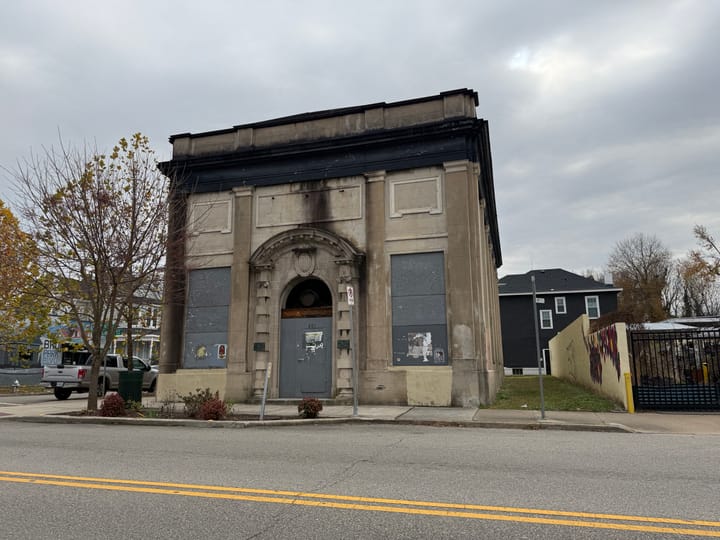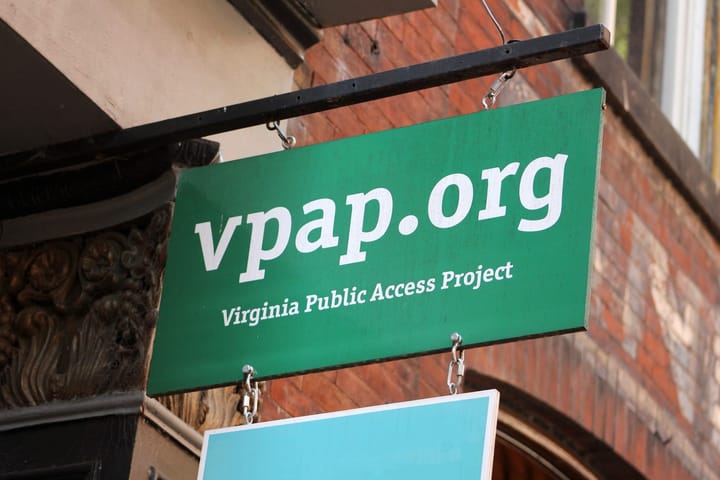Second draft of zoning overhaul draws cautious hope from neighborhood groups but some concern from housing advocates
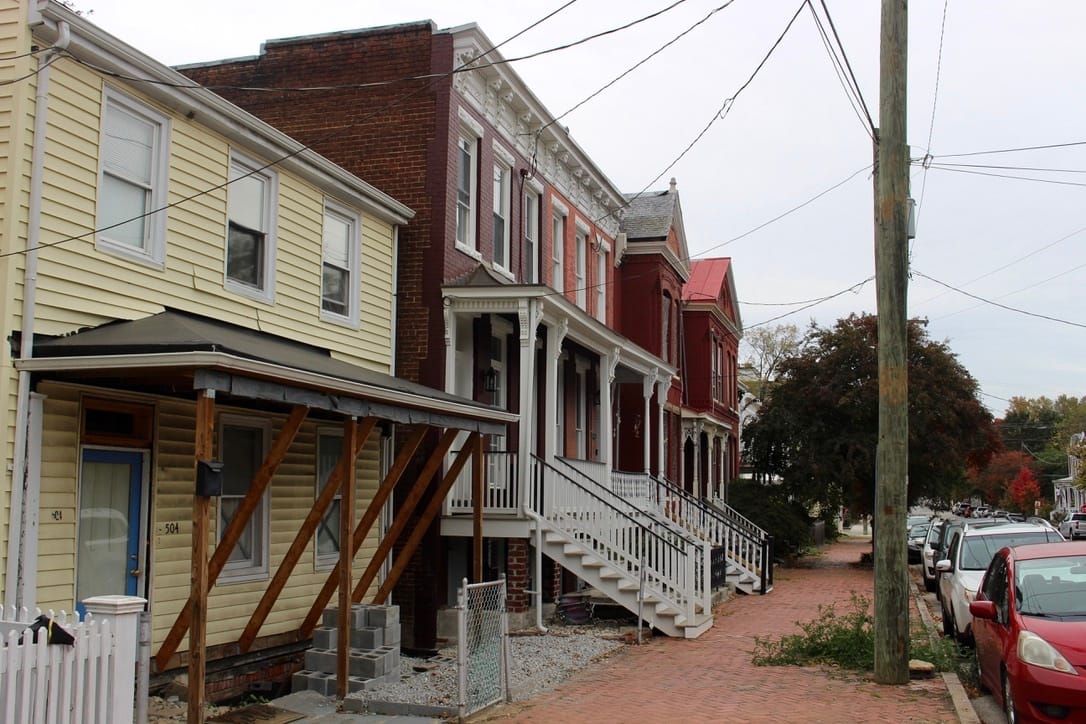
As Richmond’s Planning Commission began absorbing the details of the newest draft of the city’s zoning overhaul late Tuesday night, its members heard an unusual sentiment from a neighborhood association: praise.
“I’m really encouraged by what I’m seeing,” said John Gass, president of the Sherwood Park Association. “You know, I don’t think the house is on fire.”
On Tuesday evening, Mayor Danny Avula’s administration released the second draft of the code refresh, a comprehensive update of Richmond’s 1970s-era zoning code that aims to better match land use rules to current conditions while also increasing density as part of a broader push to address a housing affordability crisis.
Avula told The Richmonder that he believes the newest proposal is an improvement over the first “because it is reflective of what so many of the residents who had initial concerns shared.”
“I really felt like our team did a good job of hearing what residents and other stakeholders were raising,” he said.
At 284 pages and with a map covering tens of thousands of parcels, the draft now out will take some time to digest, say residents and groups. Comments have already started pouring in, and some housing organizations have flagged concerns about the removal of a duplex-by-right provision that they say could dampen the production of affordable units.
But neighborhood associations have indicated that at first glance, they see a lot more to like in the new proposal.
“I am cautiously optimistic,” said Melissa Savenko of the Fan District Association. “It seems like the staff and the consultants really listened to what they were hearing from the community.”
That could help calm some Planning Commission fears about whether the city can come up with a workable overhaul that its members and then City Council can approve. On Tuesday night, Commissioner Brian White asked Planning Director Kevin Vonck about the “political viability of these proposals.”
“Can you offer any comfort that that process is being addressed to the Council members’ satisfactions, that we’ve got enough support?” he asked.
“It’s about trying to find ways of consensus and trying to find places where we can have some overlap and agreement,” replied Vonck, who described the department’s efforts as seeking to balance the “very pro-development side of ‘just take away zoning and upzone everything’” with some residents’ “don’t change a thing” stance.
“We’re going to land somewhere in the middle,” he said.
Avula described the revision process as “like threading the needle.”
“It is finding the way to serve the most important goal for me, which is to design the kind of city we want to be — to be a kind of place where you have neighborhoods that attract residents of different levels of income and have a mixed and varied housing stock that ultimately gives residents choice … but then also balances that with some of the character and aesthetic priorities of communities that make them really charming,” he said.
Key changes
Richmond’s first code refresh draft, which came out in June, was greeted with enthusiasm by many pro-density advocates, who endorsed its rezoning of transit corridors to allow greater heights, higher limits on the percentage of a lot buildings can cover and the so-called duplex proposal, which would have allowed the construction of two units and an accessory dwelling on any residential lot.
Affordable housing builders and advocacy groups also came out strongly in support of the duplex proposal, which they said not only offers one of the few tools available to bring down building costs but also ensures growth won’t just be concentrated in the city’s poorest and most vulnerable neighborhoods.
But neighborhood associations, voluntary groups of residents who hold no formal power in the decision-making process but wield significant influence at City Hall, largely marshaled against the first draft. Concerns varied, but the most frequent criticisms centered on the view that the amount of density proposed would incentivize demolitions and erode neighborhood character.
Many of the changes in the second draft respond to those criticisms.
Limits on how much of a lot can be covered by buildings were reduced to be closer to what currently exists. Requirements for setbacks and height restrictions were rejiggered to ensure infill construction is more in line with surrounding structures. RD-C zoning, a designation that covers the densest single family neighborhoods, was used more sparingly. Many corridor designations were altered, and tree canopy standards were added to encourage the preservation and planting of trees.
The approach to residential districts made up mostly of attached homes was also reworked. While previously there were three such districts — labeled RA-A, RA-B and RA-C, with allowable density being the lowest in A and the highest in C — those have been replaced with the RA, RM-A and RM-B designations, and a new category called RM-C has been added.
The new RM districts, short for “residential multifamily,” are designed to allow multifamily units of varying sizes and appear to help calm some fears in historic rowhome neighborhoods about the potential for developers to tear down attached homes and replace them with multi-unit buildings.
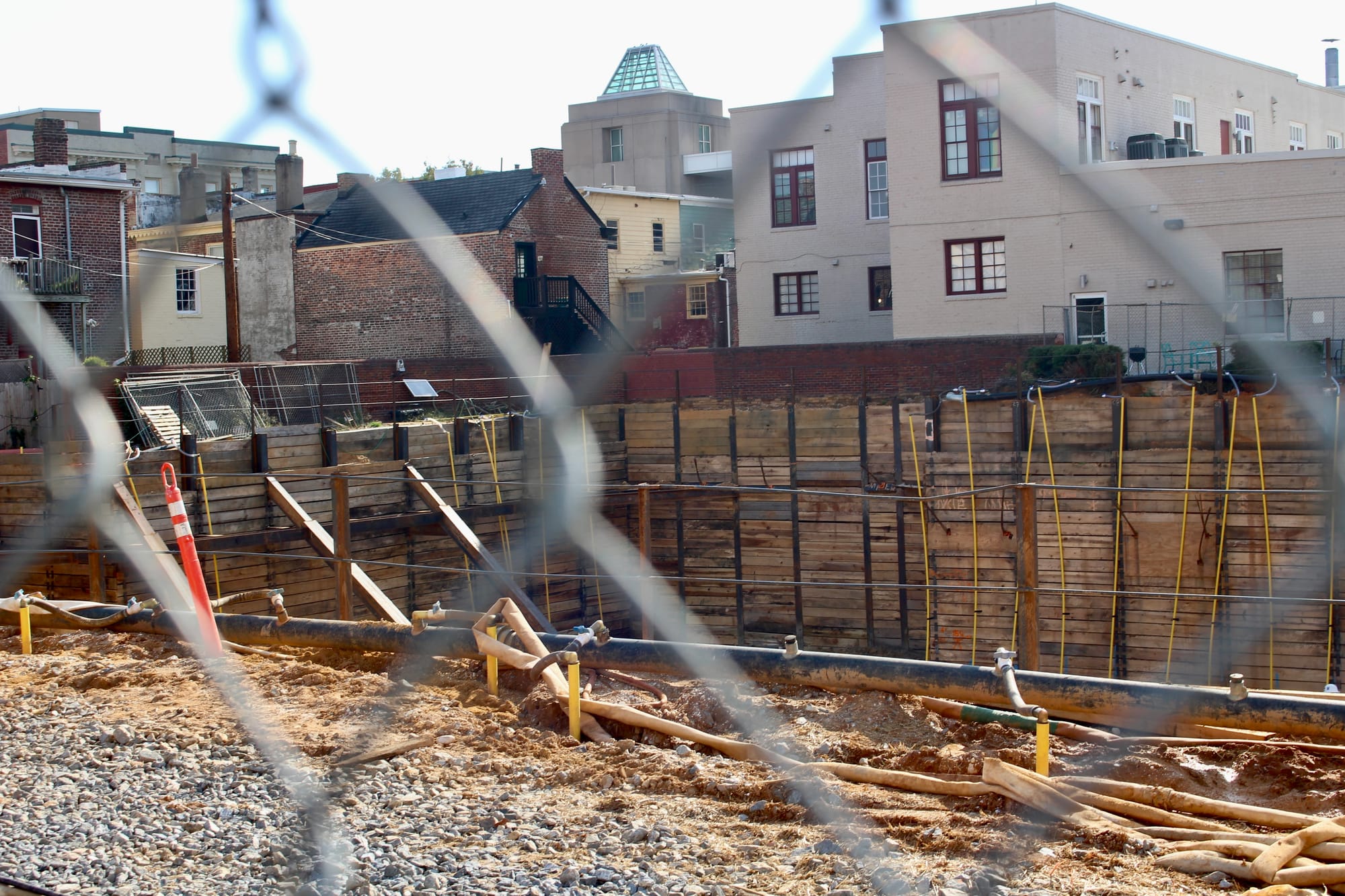
Duplex by right becomes a ‘preservation bonus’
Among the biggest of the changes is the replacement of the duplex proposal with the “preservation bonus,” an approach that lets a property owner add a second unit along with the allowed ADU only if they keep the existing building standing. Vacant lots would get two units and the ADU by right, as long as they had been vacant for five years.
Vonck described the motivation behind the shift as “trying to keep the growth or development incremental and discourage demolitions.”
Furthermore, he told the Planning Commission, limitations in the new draft would lead to the appearance from the street of only having one principal structure on each lot even if a second existed.
“You cannot go through and build side by sides,” he said. “They either go top-down or they go in the back or they go behind as part of that infill.”
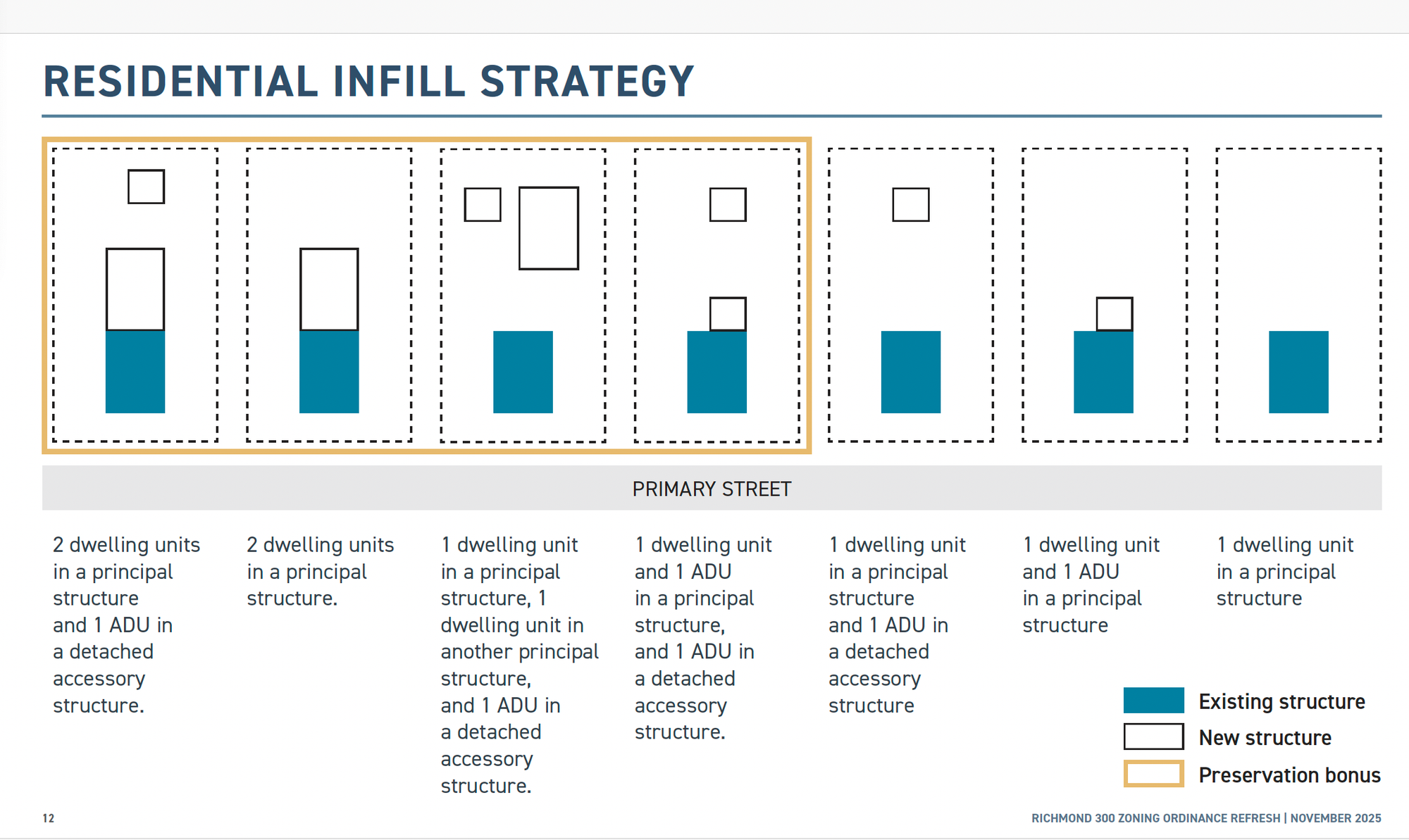
The change has already led to worry from a coalition of affordable housing developers and nonprofits, who say that realistically it may continue to hamper the construction of additional affordable units, particularly in neighborhoods where housing stock is dilapidated and requires major investments. Citywide, the vast majority of Richmond’s homes are decades old: According to Planning Department figures, 81% of the city’s roughly 68,000 structures are over 50 years old, and 23% are more than a century old. Their conditions vary dramatically.
Preserving an existing house “doesn’t always necessarily work out,” said Greta Harris, CEO of the Better Housing Coalition, which among other projects around Richmond is leading the redevelopment of the portion of Highland Grove reserved for affordable homeownership.
Still, she told The Richmonder, “we believe [the draft] is moving in a direction that ensures a fair and equitable rethinking of the code.”
Laura Dobbs, director of policy for Housing Opportunities Made Equal, said in an email that the preservation bonus would continue to allow owners “to demolish a single-family home and replace it with a larger, pricier ‘McMansion’ — something that is already happening today.”
“By contrast, the path to creating a more affordable, more abundant housing option would face obstacles,” she wrote.
Will Wilson of RVA YIMBY, the local chapter of a nationwide network whose name is an abbreviation of the phrase “Yes In My Backyard,” called the move “an unprecedented, across-the-board micromanaging of property and neighborhoods.”
When combined with lower limits on how much of a lot buildings can cover, “this change will almost certainly result in fewer homes being built,” he wrote before urging the city to reconsider. “Linking the next incremental housing unit to high-brow ‘character’ goals risks distorting incentives for more accessible housing and ultimately jeopardizes the city’s ability to meet the targets” in its affordable housing plan.
Savenko of the Fan District Association was more positive about the idea.
“I had never thought of that as a potential solution, so I want to think about it a little more, but it seems like a fair compromise that can solve a lot of problems that the historic neighborhoods were very concerned about,” she said.
Taking all the changes together, Planning Commissioner Ellen Robertson, who also represents Richmond’s 6th District in City Council, on Tuesday night told Vonck that “this sounds like a major reduction in density.”
Vonck rejected that assessment.
“I would say no,” he said. “It’s still a very pro-housing code that got rid of some of the loopholes that allowed for things that weren’t quite incremental, especially in the residential areas. … It still allows for that additional unit to happen throughout most neighborhoods.”
Furthermore, he said, the second draft “still provides a decent amount of density along the transit corridors and in mixed use.”
Seeking public feedback
Avula acknowledged that many of the revisions to the second draft respond to the views of property owners.
“The second draft may seem like it leans that way, because that’s predominantly who came out,” he said, although he pointed out the city is beginning to hear more from the affordable housing industry and other groups — feedback that he said is very welcome.
“Almost 60% of Richmond residents are renters. And clearly that is not the predominant voice that weighed in on this, but it is a voice that we need to hear from. And, you know, we have a large and growing swath of non-English-speaking residents,” he said. “So I think in these subsequent rounds of engagement, it’s also on us to get out into these communities.”
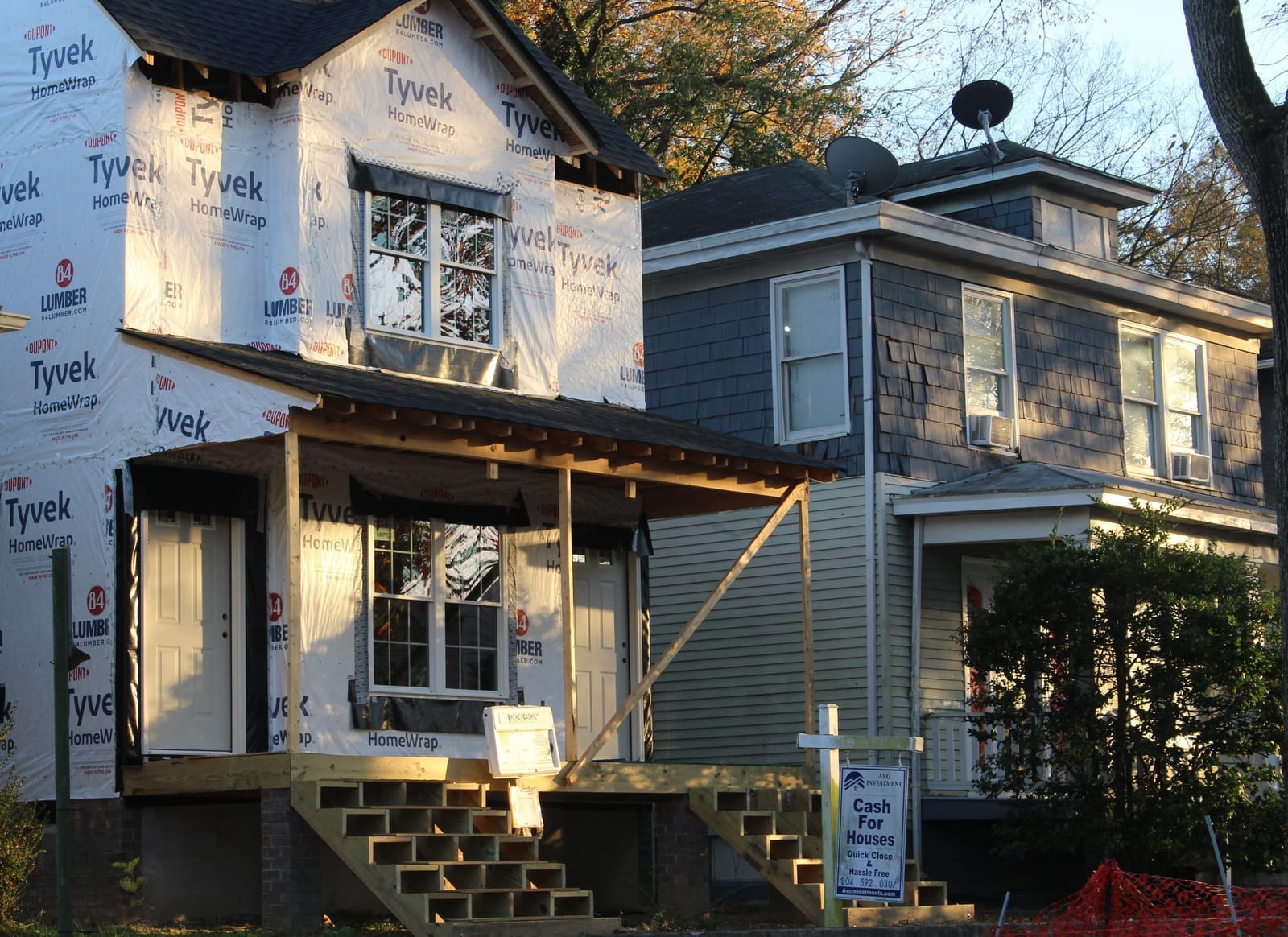
Officials have signaled the larger timeline for the refresh has been slowed down considerably. While prior conversations had indicated the city hoped to have a draft to City Council for its review this winter or early spring — a schedule that sparked significant criticism from neighborhood groups — Avula told The Richmonder that the city now is only hoping to wrap up engagement on the second draft in the first quarter of 2026. Separately, Vonck told the Planning Commission that the administration has “committed to at least three drafts.”
“It’s finding the sweet spot between dragging a process out way too long but also giving it enough time for people to really make sure their voices are heard,” said Avula.
Planning Commission Vice Chair Elizabeth Greenfield cautioned Vonck against “putting a hard timeline out there.”
“If you start putting timelines out there, people think that they’ve lost the chance to engage, and it worries them. They think it’s done.”
Vonck also pledged that the city would conduct fresh rounds of public engagement on the second draft. During the first round, about 4,425 people attended various events related to the refresh and Planning Department staff attended 42 civic group meetings while also conducting roundtables and sending out ambassadors to reach otherwise underrepresented communities.
Patty Merrill, who heads the Westhampton Civic Association, said that while many of the changes evident in the new draft seem positive “and show that the city was listening to some of the deepest concerns of residential property owners,” she remains worried about the city’s approach to involving community members in the second round.
“Three open houses within 72 hours of releasing a 284-page document, the pressures of year-end activities and holidays, and no clarity on how long we will have to make comments provides citizens little confidence that their voice will be heard,” she said. “Neighborhood associations want a way to meaningfully collaborate.”
Gass of the Sherwood Park group also urged the city to consider another round of open houses besides the three it held this week to introduce the new plan to the public.
Avula promised that the city isn’t taking the engagement process “lightly.”
“I just want Richmond to know we’re really committed to that process, and if it takes longer, it’s going to take longer,” he said.
Contact Reporter Sarah Vogelsong at svogelsong@richmonder.org. (Harris serves on the board of The Richmonder, but did not influence or review this story.)


